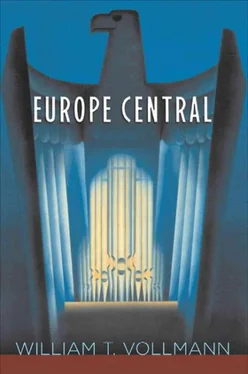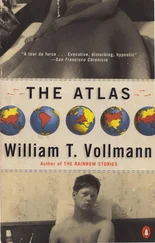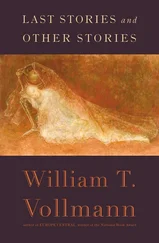597 Comrade Bley: “Based on the teachings of Lenin, she envisioned a necessary direction for the workers’ and farmers’ movement in socialist legislation”—Steding (Bley); Hau-Bigelow, p. 12.
597 Honecker: “Only a shambles was left of Adenauer’s ‘policy of strength’”—Op. cit., p. 213.
598 Tale of Benjamin’s forced retirement—Benjamin Stasi file, p. BStU 000178, Haupt-abteilung XX/1/I, Berlin, den 19.6.67.
598 Description of the restricted area where Benjamin, Ulbricht and other privileged Party members lived—Carola Stern, Ulbricht: A Political Biography, trans. and adapted by Abe Farbstein (New York: Praeger, 1965; n.d. for orig. German ed.), p. 196.
599 “Seventy-five percent of our judges in the regional and district courts derived from the working class [by 1967]”— GDR: 300 Questions, p. 67.
599 “To be remembered here is her impartiality…”—Steding (Sorgenicht); Hau-Bigelow, p. 9.
599 Statistics on farms and industrial enterprises confiscated in East Germany (actually by 1974)— Great Soviet Encyclopedia, loc. cit., p. 316.
599 The prank calls about the coffin—Benjamin Stasi file, p. BStU 000191, Haupt-abteilung XX/1, Berlin 12.8.71. I have altered this incident substaantially.
In Berlin in 2003, Juliane Reitzig, a pretty woman in her twenties, answered my questions about growing up in the DDR as follows: “School was very military-like. You had to show effort, you know. It wasn’t like, here’s a little book about the bees and you know what. It was very political. In third grade they were already introducing us to the documentaries about the Holocaust. The Americans were our enemies and the Russians were our friends, of course. The Nazis were bad, of course. We the Communists, we were the good people. There wasn’t any talk of Eastern Germans being involved in Nazis. It was always the West Germans who were the bad ones… They were encouraging us to have pen pals. I was excited, but at the same time they were checking to be sure that we were really writing letters. They would organize holidays if we were making an effort. They would organize trips to Russia… There were a lot of people who had more than others, especially those who were in the SED, the Party. Everybody had a job. Everybody had a place to live. But it was a planned economy… My parents, they told me that they had applied to leave for the West, they said, don’t tell anyone, but I told my best friend, and her grandfather was actually working for the Stasi. There were rumors, and later on they found out he was there for sure. I never really went back to where I used to live. I have a dislike for that man, and also for other people who were very directly involved in that politics… Most people wanted the reunification.” Juliane did not immediately recognize the name Hilde Benjamin. About the destruction of Dresden she said, “I really don’t know all the historic details beyond the bombing, but there was a regime in power that needed to be stopped.”
WE’LL NEVER MENTION IT AGAIN
601 Epigraph—“Everywhere that Torah is studied at night…”—Matt, p. 90 (“The Hidden Light,” from zohar 2, 213-14).
602 “My dear lady, thank you for your, your, you know, but I, I, well, I simply took a simple little theme and I did my simple, simple best to develop it!”—Grossly exaggerated from Wilson, p. 325 (testimony of Evgeny Chukovsky: Shostakovich on the First Cello Concerto).
WHY WE DON’T TALK ABOUT FREYA ANYMORE
611 Epigraph: “There is something fearful…”—Nathaniel Hawthorne, Tales and Sketches (New York: Library of America, 1982), p. 402 (“Monsieur du Miroir,” rev. version of 1846).
In various stories, especially this one and “Opus 110,” descriptions of Dresden before its destruction are based on the text and photographs (which are labeled with such helpful indicators as “zerstört, später abgebrochen”) in Fritz Löffler, Das alte Dresden: Geschichte seiner Bauten (Leipzig: E. A. Seemann Verlag, 1999, repr. of 1995 ed.). A few details of Dresden in the 1960s derive from Jean Edward Smith, Germany Beyond the Wall: People, Politics… and Prosperity (Boston: Little, Brown & Co., 1979, rev. of 1967 ed.). This author visited Dresden in 1967.
612 Photographs of Dresden in the first years after the bombing—Christian Borchert, zeitreise: Dresden 1954-1995 (Dresden?: Verlag der Kunst, 1996). The window display at “Honetta Damenmoden” was actually photographed in 1956, not 1960, the year of Lina’s visit; it probably looked slightly less sparse by then.
613 Photographs of destroyed Dresden, including corpses—Richard Peter, Dresden: Eine Kamera klagt an (Halle/Saale: Fliegenkopf Verlag, n.d., ca. 2000).
613 Lesbian venues and typologies in Weimar Berlin—Mel Gordon, Voluptuous Panic: The Erotic World of Weimar Berlin (Los Angeles: Feral House, 2000).
616 The Russians “separated themselves; they had their own place”—In the interview cited earlier (for “The Red Guillotine”), Juliane Reitzig said the following about the Soviet troops: “I think people were afraid of the Russian soldiers, but at the same time you had to like them. They separated themselves; they were in this airbase; they had their own place. Rarely saw them on the street; there were guards in the separate areas.”
616 Information on continuing widespread rape of German women by Russian soldiers in Dresden and other parts of East Germany—Fritz Löwenthal, News from Soviet Germany, trans. Edward Fitzgerald (London: Victor Gollancz Ltd., 1950). Bruce (p. 47) tells a nasty story of Red Army men with syphilis who, released from a hospital for a night out, raped East German women in Brandenburg. One reason that so many SED members resisted Russian domination was these rapes. The tale of Vice-Landrat Beda also comes from this source.
OPERATION WOLUND
620 Epigraph: “Was their ill fate sealed when in they looked.”— Poetic Edda, p. 164 (“Volundarkvitha,” stanza 21).
OPUS 110
622 Epigraph on the “‘sweet biscuits’ of culture”— The Soviet Way of Life, p. 409 (ch. 9: “The Society of Great Culture”).
622 Shostakovich’s cornucopia of food—G. Glikman (1945), in Schmalenberg, p. 182 (trans. by WTV).
623 Sovetskaya Musika: “It is impossible to forget that Shostakovich’s work…”—Walter Z. Laquer and Geroge Lichtheim, The Soviet Cultural Scene 1956-1957 (New York: Atlantic Books / Frederick A. Praeger, 1958), pp. 13-14, citing Sovetskaya Musika , 1956, no. 3, p. 9.
624 Akhmatova: “As if every flower burst into words”—Akhmatova (Hemschemeyer), p. 276 (“Music,” Zh. 452), “retranslated” by WTV.
624 V. Berlinsky on Shostakovich: “a lump of nerves”—Wilson, p. 244.
624 Eighth Symphony as “repulsive, ultra-individualist”—MacDonald, p. 191. The denouncer was Viktor Belyi, and the setting was, of course, the infamous Union of Soviet Composers’ congress in January 1948.
625 A nineteeth-century French traveler: “The Russians are not ghosts…”—Dumas, p. 55.
626 Zhdanov: “Leninism proceeds from the fact that our literature cannot be politically indifferent…”—Robert V. Daniels, ed., A Documentary History of Communism in Russia from Lenin to Gorbachev (Hanover, New Hampshire: University Press of New England, University of Vermont, 1993), pp. 236-37 (Report to the Leningrad Branch of the Soviet Union of Writers and the Leningrad City Committee of the Communist Party, 21 August 1946).
627 Mikhail Nikiforovich: “Begging your pardon, my dear Svetlana Alliluyeva”—Biagi, p. 23. (“Begging your pardon, my dear Svetlana Alliluyeva” was my Shostakovian addition.)
Читать дальше












